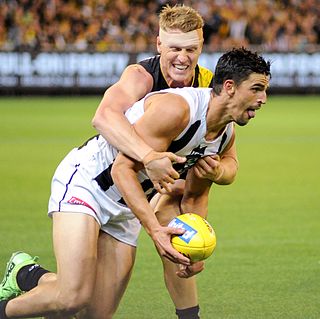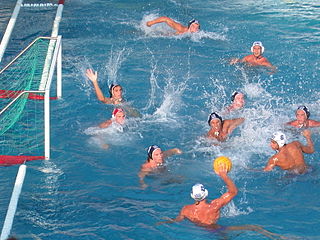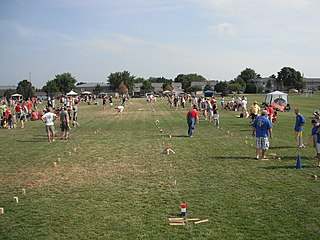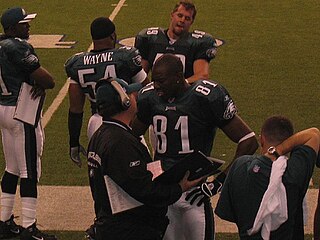
Canadian football, or simply football, is a sport in Canada in which two teams of 12 players each compete on a field 110 yards (101 m) long and 65 yards (59 m) wide, attempting to advance a pointed oval-shaped ball into the opposing team's end zone.

Most forms of football have a move known as a tackle. The primary purposes of tackling are to dispossess an opponent of the ball, to stop the player from gaining ground towards goal or to stop them from carrying out what they intend.

Gaelic football, commonly known as simply Gaelic, GAA or football, is an Irish team sport. A form of football, it is played between two teams of 15 players on a rectangular grass pitch. The objective of the sport is to score by kicking or punching the ball into the other team's goal or between two upright posts above the goal and over a crossbar 2.5 metres above the ground.

Water polo is a competitive team sport played in water between two teams of seven players each. The game consists of four quarters in which the teams attempt to score goals by throwing the ball into the opposing team's goal. The team with more goals at the end of the game wins the match. Each team is made up of six field players and one goalkeeper. Excluding the goalkeeper, players participate in both offensive and defensive roles. It is typically played in an all-deep pool where players cannot touch the bottom.

Softball is a popular variation of baseball, the difference being that it is played with a larger ball on a smaller field and with only underhand pitches permitted. Softball is played competitively at club levels, the college level, and the professional level. The game was first created in 1887 in Chicago by George Hancock.

Kubb is a lawn game where the objective is to knock over wooden blocks by throwing wooden batons at them. Kubb can be described as a combination of bowling and horseshoes. Play takes place on a small rectangular playing field, known as a "pitch". "Kubbs" are placed at both ends of the pitch, and the "king", a larger wooden block, is placed in the middle of the pitch. Some rules vary from country to country and from region to region, but the ultimate objective of the game is to knock over the "kubbs" on the opposing side of the pitch, and then to knock over the "king", before the opponent does. Games can last from five minutes to well over an hour. The game can be played on a variety of surfaces such as grass, sand, concrete, snow, or even ice.

Candlepin bowling is a variation of bowling that is played primarily in the Canadian Maritime provinces and the New England region of the United States. It is played with a handheld-sized ball and tall, narrow pins that resemble candles, hence the name.
Dead ball is a term in many ball sports in which the ball is deemed temporarily not playable, and no movement may be made with it. Depending on the sport, this event may be quite routine, or more uncommon.

Polocrosse is a team sport that is a combination of polo and lacrosse. It is played outside, on a field, on horseback. Each rider uses a cane or fibreglass stick to which is attached a racquet head with a loose, thread net, in which the ball is carried. The ball is made of sponge rubber and is approximately four inches across. The objective is to score goals by throwing the ball between the opposing team's goal posts.

A baseball field, also called a ball field or baseball diamond, is the field upon which the game of baseball is played. The term can also be used as a metonym for a baseball park. The term sandlot is sometimes used, although this usually refers to less organized venues for activities like sandlot ball.
In baseball, interference occurs in situations in which a person illegally changes the course of play from what is expected. Interference might be committed by players on the offense, players not currently in the game, catchers, umpires, or spectators. Each type of interference is covered differently by the rules.

The rules of basketball are the rules and regulations that govern the play, officiating, equipment and procedures of basketball. While many of the basic rules are uniform throughout the world, variations do exist. Most leagues or governing bodies in North America, the most important of which are the National Basketball Association and NCAA, formulate their own rules. In addition, the Technical Commission of the International Basketball Federation (FIBA) determines rules for international play; most leagues outside North America use the complete FIBA ruleset.

A free kick in Australian rules football is a penalty awarded by a field umpire to a player who has been infringed by an opponent or is the nearest player to a player from the opposite team who has broken a rule.

A comparison of American football and rugby union is possible because of the games' shared origins, despite their dissimilarities.

Newcomb ball (also known simply as Newcomb, and sometimes spelled Newcombe (ball)) is a ball game played in a gymnasium or court using two opposing teams and a net. Newcomb ball and the sport of volleyball were both created in 1895 and are similar in their design. The sport rivaled volleyball in popularity and participation by the 1920s. The sport of throwball may be a possible relative.

Cornhole is a lawn game popular in North America in which players or teams take turns throwing fabric bean bags at an inclined board with a hole in its far end. The goal of the game is to score points by either landing a bag on the board or putting a bag through the hole.
This is an alphabetical list of selected unofficial and specialized terms, phrases, and other jargon used in baseball, along with their definitions, including illustrative examples for many entries.

This list is an alphabetical glossary of Australian rules football terms, jargon and slang. While some of these entries are shared with other sports, Australian rules football has developed a unique and rich terminology.

In sports, out of bounds refers to being outside the playing boundaries of the field. The legality of going out of bounds, and the ease of prevention, vary by sport. Sports that use this term include American football, Canadian football, field lacrosse, basketball, rugby union, rugby league, and association football.

The laws of Rugby Union are defined by World Rugby and dictate how the game should be played. They are enforced by a referee, generally with the help of two assistant referees.

















